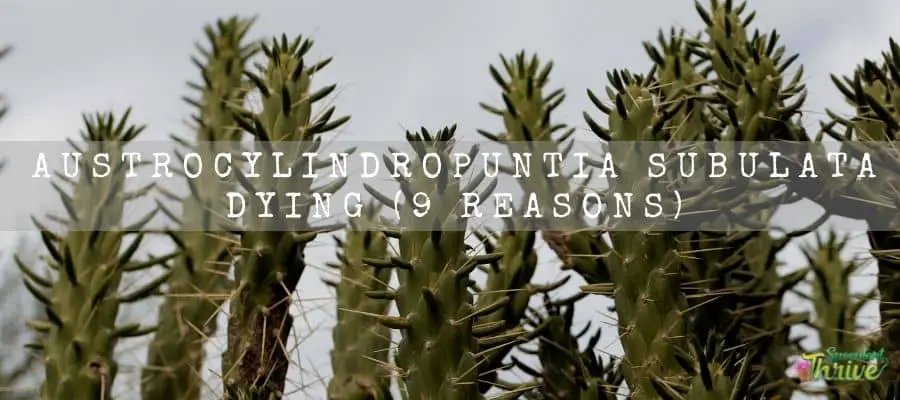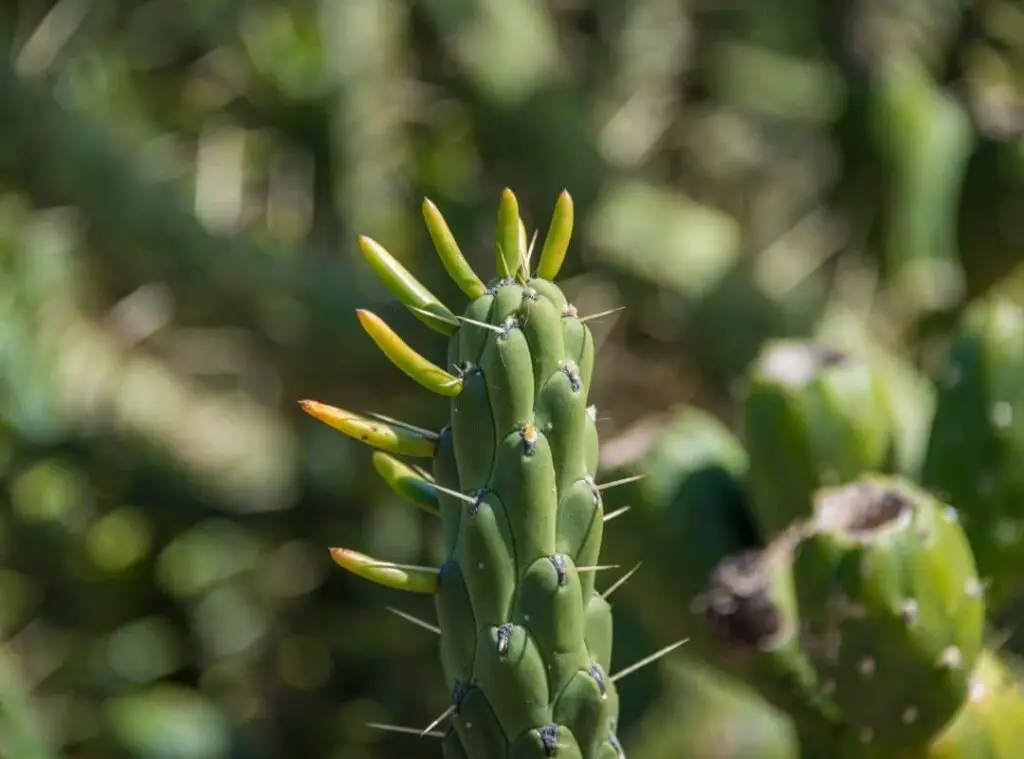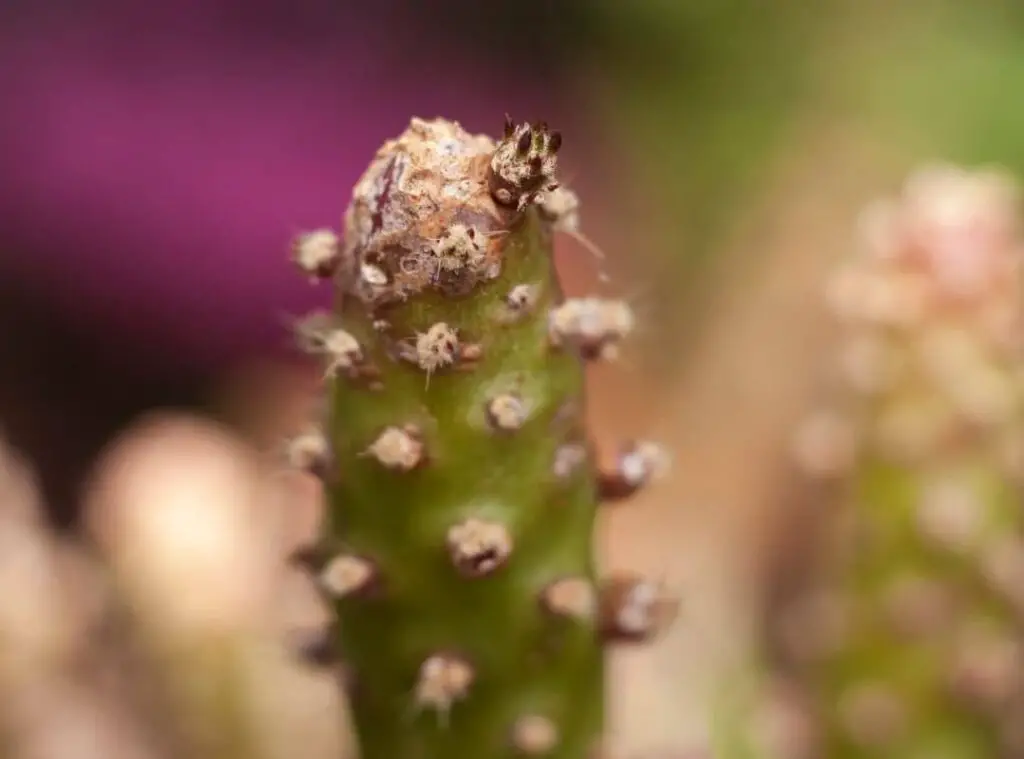Is your Austrocylindropuntia subulata dying ? There could be several reasons for this. In this article I am going to discuss those reasons in detail.

01.Austrocylindropuntia subulata bacteria
Did you know Austrocylindropuntia subulate may suffer from Erwinia carotovora bacteria quite often. When Austrocylindropuntia subulata are affected by this bacteria, Ultimately they would contribute to soft rot of the plant.
This bacteria would tend to invade the plants if there are any natural openings, wounds on the plants.
Further if there are high humidity levels, it would be beneficial for them to reproduce faster and attack the rest of other healthy plant parts as well.
Once the bacteria attack, it would make the plant’s tissues look watery and soft. Further it would turn black in color too.
Eventually it would result in the health deterioration of the entire plant. Hence, best would be to avoid wounds and ensure the plants are doing well.
Further if you spot any broken spaces, you need to treat them at the very moment you spot them. To treat them, you could use a copper fungicide and refrain from exposing plants for high humidity levels.
02. Austrocylindropuntia subulata fungal diseases
Austrocylindropuntia subulata may go through several fungal diseases such as Colletotrichum (Gleosporium) spp, Stevensea (Diplotheca) wrightii): Phyllosticta concava and Mycosphaerella spp etc.
Once the plants go through this condition, you would see how the plants suffer from moist light brown rot.
They would tend to develop light pink pustules on the surfaces too. Those spots would be small at first and they would enlarge as they mature. Furthermore, they would tend to carry small spores producing pustules too.
This fungus type would mainly affect the large areas of the plants and chances are that it may destroy the entire plants.
There is not much you could do to overcome them and ideally you need to discard the infected plants right away.
If you have grown these plants in greenhouses, you need to remove the infected soil as well as the infected benches. You could overcome this disease by using a copper fungicide.
On the other hand, Austrocylindropuntia subulata plants may go through charcoal spot fungal disease as well. The root cause for this would be Stevensea (Diplotheca) wrightii): This is commonly spotted fungal infection among
Austrocylindropuntia subulata plants. It could be destructive too. At the beginning they would tend to develop small spots in one fourth inches or even more in diameter.
Further you could see how those spots are covered with rings of small dots as well. Those are fruiting structures and those spots would enlarge and would tend to remain as separate.
Unfortunately, there is no way that you could overcome them and what you could ideally do is to discard the plants.
Phyllosticta concava and Mycosphaerella spp fungi cause dry rot in these plants. Once Austrocylindropuntia subulate suffer from dry rot, you could see them as small black spots.
Those spots would tend to take a circular shape. Moreover, those spots would be small at the beginning and tend to enlarge once they spread further.
In fact, they would be about one or two inches in diameter. If you further inspect the callus tissue, you could see how severely it has spread. What I suggest you do here is to discard the infected plants if you ever come across this condition.
In addition to aforesaid, chances are that Austrocylindropuntia subulate may also experience fungal attacks from Hendersonia opuntiae which could result in scorch or sunscald in the plants.
At the start you could see the spots are more distinctly zoned. They would also tend to get larger as they spread further.
Further you could see the center of the infected area look gray, brown in color. Ultimately it would result in the deaths of the plants too. There is no effective way of getting rid of this infection as yet.

03. Austrocylindropuntia subulata root rot.
The fungus called Phymatotrichum omnivorum may cause the plants to suffer from root rot. You may call these fungus as cotton root fungus as well. You could see them as brown strands when you try to pull the plants from the soil.
This is commonly spotted around the root surface of the plants. Unfortunately, they would result in the death of the plants and none of the remedies would work with them.
04. Austrocylindropuntia subulata stem rot
The fungus Drechslera cactivorum is what could result from the stem rot of the cacti. Once these plants suffer from stem rot, you could see them as yellow spots.
They could be so severe to the level that it could even kill the plants within a short period of four days. There are some fungicides which could overcome this condition.
05. Austrocylindropuntia subulata nematodes
Austrocylindropuntia subulata plants are prone for root rot nematodes mainly. Once they infested with the root rot nematodes, you would see them carrying small galls and you could commonly spot them when they are clean.
I recommend fumigating or sterilizing the soil before potting them so that it would act as a preventive measure.
06. Austrocylindropuntia subulata overwatering
Over watering could be something which could be troublesome for the plants. Further chances are that it could turn out to be fatal on the plants as well.
If you end up over watering the plants specially during high humidity levels, it will cause root rot. Austrocylindropuntia subulata plants have water conserved in the plants and once you supply them water in excess it would result in the rupture of cacti cells.
To remedy them, you need to first remove the plants from the pot and let the soil wither. After that you could pot them again.
However, if the root rot has spread on a massive level, it is very unlikely you could save the plants.
In that case, best would be to get rid of the infected plants and use the healthy plants parts for propagation. Once the plants suffer from over watering you could see how the plants leaves become swollen. Ultimately it would result in the rupture of the cells as well.
07. Austrocylindropuntia subulata underwater
Under watering could also result in so many adverse repercussions on these plants. One might think that Austrocylindropuntia subulata plants do not require water as they have conserved water in the plants.
However, it is a myth as they need some amount of water and ideally what you could do is water them moderately whenever their soil is dry.
Lack of water would make their plants’ leaves shriveled. Further it would cause the wilting of the plants too. Ultimately, they would tend to shed the leaves as well.
To remedy you need to water the plants well whilst ensuring that you allow their soil to dry between two watering sessions. That will help the plants to recover.

08. Austrocylindropuntia subulata sunburn
If you expose the plants for direct sunlight for too long, it will make the plants sunburnt. This is commonly spotted particularly if you had grown them in shade and if you exposed them to direct sunlight abruptly.
On the other hand, if you had to feed the plants and leave them under direct sunlight it would also pave the way for sunburns. In fact, the over exposure for sunlight would burn the plants epidermis which will badly impact on the overall growth of the Austrocylindropuntia subulata plants.
Once they go through this condition, you would see them forming brown spots and you cannot get rid of those marks irrespective of what you do. In other words, the sunburnt spots would remain on the plants forever and make the plants look aesthetically less attractive.
If your precious Austrocylindropuntia subulata plants go through this condition, you need to immediately relocate the plants to somewhere shady so that you could overcome further repercussions.
Further you may spray some water and cover the plants with a small bag for a few days. Further you need to shield the plants particularly from the direct sunlight in summer so that you do not have to go through these conditions. If the sunburns get severe , it may even kill the plants.
09. Austrocylindropuntia subulata dried out
Under watering could be the main root cause for the drying out of the Austrocylindropuntia subulata plants.
Having said that, if you spot the leaves at the bottom that are dried out, it could be a part of their natural growth pattern too. To elaborate further on this, the older leaves would tend to dry up and end up falling on the ground and that is something which you could ignore.
Read Next : Crested Echeveria Frosty | An Unusual Succulent |
